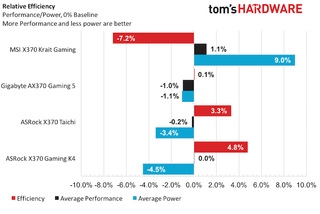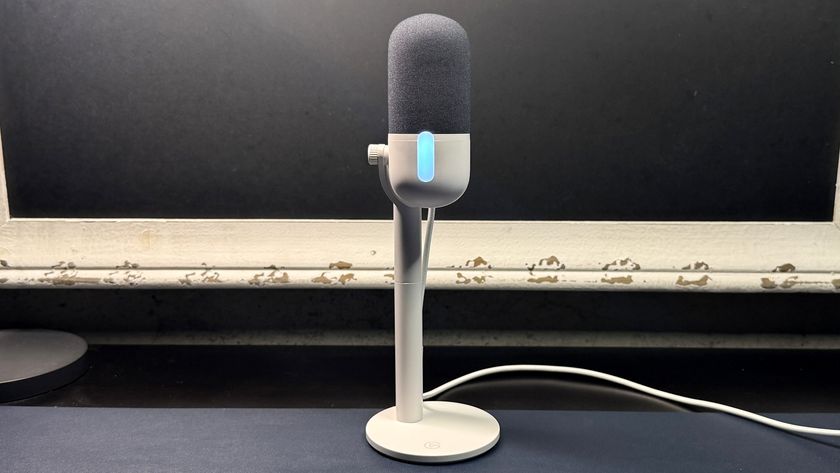MSI X370 Krait Gaming Motherboard Review
Why you can trust Tom's Hardware
Benchmarks & Final Analysis
Corsair’s H110i still cools this Ryzen 7 1700X sample, and we apply a fresh application of thermal compound. The “Tumbler” is still our enclosed test rig, hosting our GTX 970 GPU, OCZ RD400 M.2 drive, Corsair AX860 PSU, and various other drives.

Benchmarks
| Synthetic Benchmarks And Settings | |
|---|---|
| PCMark 8 | Version 2.7.613 Home, Creative, Work, Storage, Applications (Adobe & Microsoft) |
| SiSoftware Sandra | Version 2016.03.22.21 CPU Arithmetic, Multimedia, Cryptography Memory Bandwidth |
| DiskSPD | 4k Random Read, 4k Random Write 128k Sequential Read, 128k Sequential Write |
| Cinebench R15 | Build RC83328DEMO OpenGL Benchmark |
| CompuBench | Version 1.5.8 Face Detection, Optical Flow, Ocean Surface, Ray Tracing |
| 3D Tests And Settings | |
| 3DMark 13 | Version 4.47.597.0 Test Set 1: Skydiver, 1920x1080, Default Preset Test Set 2: Firestrike, 1920x1080, Default Preset Test Set 3: Firestrike Extreme, 2560x1440 Default Preset |
| Application Tests And Settings | |
| HandBrake CLI | Version: 0.9.9 Sintel Open Movie Project 4.19 GB 4k mkv to x265 mp4 |
| LAME MP3 | Version 3.98.3 Mixed 271MB WAV to mp3 Command: -b 160 --nores (160 Kb/s) |
| Adobe After Effects CC | Release 2015.3.0 Version 13.8.0.144 PCMark driven routine |
| Adobe Photoshop CC | Release 2015.5.0 20160603.r.88 x64 PCMark driven routine (light and heavy) |
| Adobe InDesign CC | Release 2015.4 Build 11.4.0.90 x64 PCMark driven routine |
| Adobe Illustrator | Release 2015.3.0 Version 20.0.0 (64-bit) PCMark driven routine |
| Blender | Version 2.68a BMW 27 CPU Render Benchmark BMW 27 GPU Render Benchmark |
| 7-Zip | Version 16.02 THG-Workload (7.6 GB) to .7z, command line switches "a -t7z -r -m0=LZMA2 -mx=9" |
| Game Tests And Settings | |
| Ashes of Singularity | Version 1.31.21360 High Preset - 1920x1080, Mid Shadow Quality, 1x MSAA Crazy Preset - 1920x1090, High Shadow Quality, 2x MSAA High Preset - 3460x1920, Mid Shadow Quality, 1x MSAA Crazy Preset - 3460x1920, High Shadow Quality, 2x MSAA |
| F1 2015 | 2015 Season, Abu Dhabi Track, Rain 1920x1080 - UltraHigh Preset, 16x AF 3460x1920 - UltraHigh Preset, 16x AF |
| Metro Last Light Redux | Version 3.00 x64 High Quality, 1920x1080, High Tesselation Very High Quality, 1920x1080, Very High Tesselation High Quality, 3460x1920, High Tesselation Very High Quality, 3460x1920, Very High Tesselation |
| The Talos Principle | Version 267252 1920x1080 - Medium Preset, High Quality, High Tesselation, 4x AF 1920x1080 - Ultra Preset, VeryHigh Quality, VeryHigh Tesselation, 16x AF 3460x1920 - Medium Preset, High Quality, High Tesselation, 4x AF 3460x1920 - Ultra Preset, VeryHigh Quality, VeryHigh Tesselation, 16x AF |
Synthetics & Applications
After that overclocking segment, we want to slow things down with some good ol’ synthetic data. Synthetic performance can be exceptionally boring, but it is a necessary evil to confirm base level performance and confirm theoretical and marketing specifications as a sanity check. PCMark results come as no surprise with less than one percentage point separating all four boards when comparing average metric scores. The Adobe portion of these tests shows the largest score delta, with the ASRock Taichi showing strong performance and the MSI Krait bringing up the rear.

For Sandra Arithmetic and Multimedia, the Krait's performance is average. Cryptography and memory bandwidth scores hand the Krait a first and second place finish, respectively. (Note at DDR4-3200MHz, bandwidth for the Krait is at 36GB/s.)




If it wasn’t for the FaceDetect workload in CompuBench, the MSI X370 Krait Gaming would have swept these tests, but sometimes workloads just act funny.


Shifting the focus to the GPU for synthetics, 3DMark shows a combined score win for the Krait in the Skydiver workload, a third place finish in Firestrike, and the checkered flag in Firestrike Extreme.



Application data is also less than exciting. Handbrake, Blender, Lame, and Adobe all show instances where seconds are separating the different samples. 7-Zip bucks the trend showing a 30-second lead for the MSI X370 Krait Gaming.




Gaming, Performance, And Efficiency
Driving around the track in Abu Dabi in F1 2015 is always a pleasurable experience, and the Krait shows good results across the board with consistent wins at 1080p and 3460x1920 across metrics, but it falls short with a minimum frame rate loss to the Taichi at quasi-4k.


Mother Russia also favors the Taichi in Metro Last Light Redux at 1080p with higher max frame rates, but average rates for all products are more than acceptable. Turning on the other two monitors in Nvidia Surround increases the graphical strain on the system and average rates level out for this GTX 970 across samples, though we still observe higher rates on the Taichi.




Ashes of the Singularity is notorious for CPU bottle-necking, but for some reason the Krait is less susceptible. At 1080p, the MSI X370 Krait Gaming is running right in front of the pack for the High preset, but when Crazy is engaged it claims an almost three frame lead over the competition; this result is repeatable and consistent. 3460x1920 shows a similar trend, where High demonstrates similar performance across all samples, and the Krait squeaks away with the win at Crazy. Just to make sure the game didn’t get updated, we confirmed that all installations of Ashes are running the same version; no Ryzen improvements are applied.
The Talos Principle rounds out the gaming suite with slightly more variance between the Gigabyte AX370 Gaming 5 and the MSI X370 Krait Gaming at 1080p and a slight surge when Ultra is turned on, besting the ASRock boards by five frames. 3460x1920 levels the playing field for all boards and shows a one percentage point difference across samples.




Power, Heat, And Efficiency
Cranking up the load on the Krait shows its weakness: power consumption. The Krait’s hunger for performance shows, and at idle it consumes 12W more than our residing efficiency king. The system draws an additional 30W at CPU load and 40W at GPU load. Full system load brings that delta to 54W, which is the TDP spec for some lower power processors!

Across the range, that is nearly a 14% difference. My statement from the overclocking section couldn’t be truer: MSI is running higher default voltages and/or lower load lines than its competitors. Thermal deltas appear to be consistently large as well, going 10°C above the Gigabyte AX370 Gaming 5 sample using the same cooler, though this could be due to CPU sensor differences across vendors.

Note the asterisk in the chart: we did observe that the sensors were tracking differently than previous boards, so reversing the naming convention of the CPU thermal sensors was necessary. CPU Diode1 appears to track with the other Ryzen 1700X installations, so we think temperatures are still cool enough. The bulky Vreg heatsinks do not work as well as we would hope. However, with the extra voltage going through the Vregs, extra temps are expected.

With our M.2 finally back at idle and the averages of the averages all munged together, synthetics, games, and application results show the MSI X370 Krait Gaming with an above average rating in all fields. The three remaining competitors have two or three metrics that show sub-average performance. The closest competitor is the ASRock X370 Gaming K4, and our Gigabyte AX370 Gaming 5 brings up the rear.

Stacking that with power draw, the ASRock X370 Gaming K4 is still our efficiency king, and the MSI X370 Krait Gaming is the beef cake in the corner. Oh well, the 1.1% performance win is going to go on its name tag.
Value And Conclusion
Coming in nearly $30 below the average price of the competition, the MSI X370 Krait Gaming cuts corners where it counts and puts performance first to win itself the value award among the X370 boards we’ve tested so far.

The MSI X370 Krait Gaming is not the most polished product out there, and its feature set is not anything to write home about (good thing it doesn’t have a post card), but saving bucks bypassing a few features or extra in-box goodies makes this board a win in our book. UEFI support out of the box was by far the best we’ve seen from a Ryzen board to date. The Krait consumes more power than the competition, but this is usually not a high priority for the typical enthusiast. We would have liked a bit more flair to make this board pop, but if it’s going to spend its life tucked behind a panel for a more traditional performance rig, we'll give the MSI X370 Krait Gaming a Tom’s Hardware Recommended award.
MORE: Best Motherboards
MORE: How To Choose A Motherboard
MORE: All Motherboard Content
Stay On the Cutting Edge: Get the Tom's Hardware Newsletter
Get Tom's Hardware's best news and in-depth reviews, straight to your inbox.
-
logainofhades Hopefully this board will not be plagued with issues that past Krait boards have suffered.Reply -
the nerd 389 It's not mentioned in the reviews, but this motherboard does support proper 4-pin PWM fan speed control. This board is safe to use with the Corsair ML series fans on any fan header.Reply
The SYS_FAN headers must be changed to PWM mode to avoid damaging them, though.
It's nice to see a company other than Asus actually bothering to connect the fourth pin of those fan headers. -
__Isomorph__ sounds like it's going to overcook after months of intensive use with subpar components failures. not convinced that buying a new mobo again next year when this one fails is the best allocation of funds.Reply -
TheTerk @__ISOMORPH__ : I wouldn't say that the overvolting is too much of a reliability issue. When running non-overclocked, everything is running well within safe margins. If you reference the How to Overclock article, 1.39V is still a relatively safe voltage. Overclocking already voids warranties, but if the mobo breaks, RMA that sucker!Reply -
__Isomorph__ @theterk yes i was referring to the 'How to OC' article. i also watched the speech given by one of the AMD techs about how to OC Ryzen: as soon as he said 'do not go over 1.425V', i started twitching and all i could think about was 'how sweet would it be to pump 1.90v into the chip.' LOL let's hope am not gonna fry it.Reply
AMD speech on OC'ing here: https://www.youtube.com/watch?v=vZgpHTaQ10k -
Onus I've been generally impressed with MSI boards lately. I may have missed it in the description, but did this one have any diagnostic LEDs on it? I thought most of them did these days...Reply
Edit: The web site mentions EZ Debug LEDs. Please confirm.
I'm still trying to decide about a Ryzen build, and I think I'll put this board on my short list (although I may prefer something physically smaller). -
Pepe Godzilla @Onus: I have this one at home sporting a 1700, if i don't forget about it i'll have a look ;)Reply
What i can say to this point: 3200 Hynix RAMs still don't work with Version 1.3 BIOS. 2933 is no problem though. OC is very easy: 3.7GHz @ 1.2V, XMP Profile for 2933 works at first try. BeQuiet! Dark Rock Pro 3 cools everything down to 67°C at full day AIDA stress test. -
Pepe Godzilla It has a Debug LED for CPU, RAM, VGA and boot failures, a DIMM LED indicating installation, an iGPU LED for APUs and PCIe slot status LEDsReply












